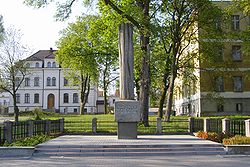- Oflag 64
-
Oflag 64 was a World War II German prisoner-of-war camp for officers located at Szubin a few miles south of Bydgoszcz, in Pomorze, Poland, which at that time was occupied by Nazi Germany. It was probably the only German POW camp set up exclusively for U.S. Army officers. At most other camps there were several nationalities, although they were usually separated into national compounds.
The camp was built around a Polish boys' school by adding barracks. Initially it was Stalag XXI-B for Polish soldiers until December 1940. It then it became Oflag XXI-B for French and British Commonwealth officers, subsequently for Soviet officers until June 1943. They were then moved out to other camps, the Commonwealth flying personnel to Stalag Luft 3 Sagan, others to Oflag XXI-C Ostrzeszów. It was then re-numbered.
Contents
Timeline
- June 6, 1943 - the camp was redesignated Oflag 64; it became an American officers-only camp with the arrival of officers captured in the North Africa Campaign in Tunisia.
- Late fall 1943 - An escape committee started digging a tunnel which was to pass under the barbed wire fence.
- March 1944 - upon receiving news of the disastrous results of the "Great Escape" from Stalag Luft III the escape committee ordered a shut-down of the operation.[1]
- June 1944 - senior American officers captured in the Battle of Normandy sent to Oflag 64.
- January 21, 1945 - the roll call established a total of 1,471. Because of approaching Soviet troops, all capable of walking were marched out. The senior U.S. officer was Lieutenant Colonel Paul Goode.[2]
- January 23, 1945, the camp was liberated by the Soviet 61st Army. There were approximately 100 Americans, sick and medical personnel, and a few that had hidden in the old escape tunnel. About 200 escaped from the marching column and returned to the camp.
Aftermath
The group that marched out of Szubin, reached Oflag XIII-B at Hammelburg on March 10. They marched through snow and bitter cold most of the nearly 400 miles. About 400 dropped out on the way, too weak to march, or escaped. A number were shot. Lt. Col. Goode marched with them the entire distance. Part of the group, including Lt. Col. Goode were again marched out to Stalag VII-A, Moosburg, where they were liberated by units of the U.S. 14th Armored Division on 29 April (three weeks after Hammelburg had been liberated by the same unit).
Those that had stayed at the camp experienced considerable difficulties. The Soviets wanted to hold them hostage, until all Soviet POWs in camps behind Allied lines were returned to them[3]. Finally, under the command of Col. Frederick Drury, they reached Odessa and were evacuated on a New Zealand ship, HMNZS Monowai.
References
Sources
- The Kriegies of Oflag 64 - very complete source with many photos and maps.
- recollections of American officers in Oflag 64
- Homepage of Oflag 64 veterans
See also
- List of German WWII POW camps
- Oflag
- Oflag XIII-B
- Oflag XXI-B
External links
Media
"Oflag 64: A P.O.W. Odyssey" was a TV documentary made by PBS in 2000.
Categories:- World War II prisoner of war camps
Wikimedia Foundation. 2010.

